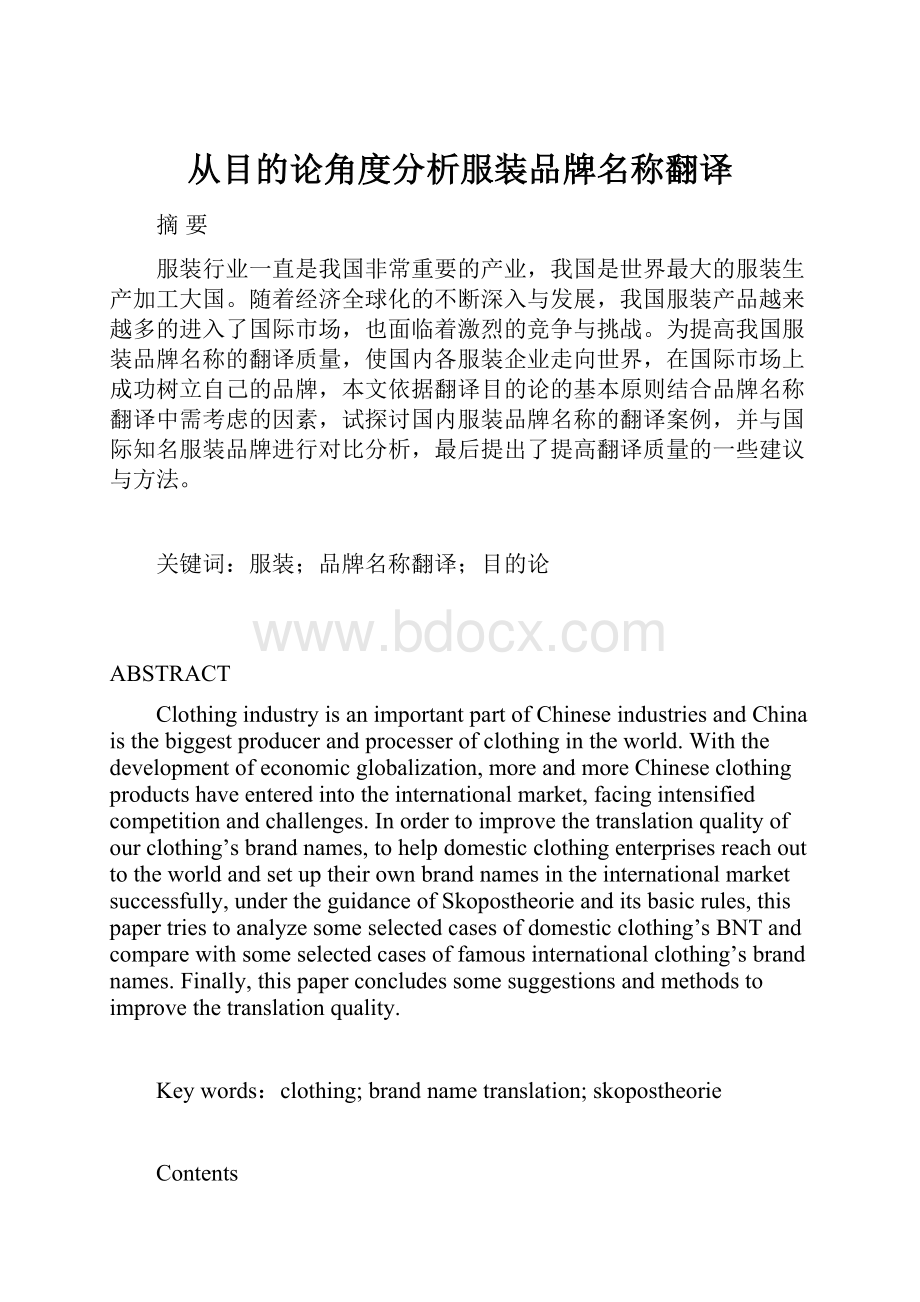 从目的论角度分析服装品牌名称翻译.docx
从目的论角度分析服装品牌名称翻译.docx
- 文档编号:24592234
- 上传时间:2023-05-29
- 格式:DOCX
- 页数:24
- 大小:35.51KB
从目的论角度分析服装品牌名称翻译.docx
《从目的论角度分析服装品牌名称翻译.docx》由会员分享,可在线阅读,更多相关《从目的论角度分析服装品牌名称翻译.docx(24页珍藏版)》请在冰豆网上搜索。

从目的论角度分析服装品牌名称翻译
摘要
服装行业一直是我国非常重要的产业,我国是世界最大的服装生产加工大国。
随着经济全球化的不断深入与发展,我国服装产品越来越多的进入了国际市场,也面临着激烈的竞争与挑战。
为提高我国服装品牌名称的翻译质量,使国内各服装企业走向世界,在国际市场上成功树立自己的品牌,本文依据翻译目的论的基本原则结合品牌名称翻译中需考虑的因素,试探讨国内服装品牌名称的翻译案例,并与国际知名服装品牌进行对比分析,最后提出了提高翻译质量的一些建议与方法。
关键词:
服装;品牌名称翻译;目的论
ABSTRACT
ClothingindustryisanimportantpartofChineseindustriesandChinaisthebiggestproducerandprocesserofclothingintheworld.Withthedevelopmentofeconomicglobalization,moreandmoreChineseclothingproductshaveenteredintotheinternationalmarket,facingintensifiedcompetitionandchallenges.Inordertoimprovethetranslationqualityofourclothing’sbrandnames,tohelpdomesticclothingenterprisesreachouttotheworldandsetuptheirownbrandnamesintheinternationalmarketsuccessfully,undertheguidanceofSkopostheorieanditsbasicrules,thispapertriestoanalyzesomeselectedcasesofdomesticclothing’sBNTandcomparewithsomeselectedcasesoffamousinternationalclothing’sbrandnames.Finally,thispaperconcludessomesuggestionsandmethodstoimprovethetranslationquality.
Keywords:
clothing;brandnametranslation;skopostheorie
Contents
1.Introduction
Brandisanabstractconceptwhichconsistsofseveralelements.Ingeneral,brandisregardedasaremarkablesignusedbycommodityproducersandoperators,forconsumerstodifferentiatethesourceofcommodities[1]1.
Brandhasseveralbasicfunctionssuchas:
distinctivefunction,namelybrandcandistinguishandindividuateaproductandacompanyfromothers;legalprotection,namelybrandcanprotecttherightsandinterestsofacompany;qualityassurance,asconsumerstendtorelatethequalityofagoodtoitsbrand,areputedbrandcanalwaysconvinceitsconsumersthatthegoodisofassuredgoodquality;establishingenterpriseimage,namelyafamousbrandcanhelptoestablishgoodenterpriseimagetomaketheenterprisemorecompetitiveamongothers.Itisapreciousintangibleassetofanenterpriseandaninexhaustibleresourceofpropertywhichplaysanimportantroleinmarketingactivity.
Abrandnameisanindispensableelementofabrandwhichcancreateidentitiesandisofsignificantvalueforthewholeenterpriseinthecompetitiveglobalmarket.Awelltranslatedbrandnamecanreflectbrandimageandconveyproductinformationwhileanotproperlytranslatedbrandnamecancauseagreatlossbothofmoneyandreputationtotheenterprise.
AfterChina’sreformandopeningup,theeconomydevelopsrapidlyandChinahasalsoenteredtheWTO,numerousChineseproductshavecomeintotheworldmarket.Inordertoestablishasuccessfulinternationalbrand,anexcellentbrandnameandagoodtranslationshouldbetakenasthefirstandforemostmatterbecauseawelltranslatedbrandnamecontributestothegoodreputationofacompanyanditsproducts.
NowadaysChineseClothingindustryhasbecomeanimportantpartoftheinternationalclothingindustry.Inordertoimprovetheircompetitivestrength,manyforeigntradeenterprisesofclothinghaveattachedgreatimportancetobrandstrategyinordertosetuptheirownbrandimageintheworldmarket.Asakindofnecessarydailycommodity,thesignificanceofclothing’sBNTdeservesourspecialattention.
Thispaperwillexplorethetranslationofclothing’sbrandnamesbyanalyzinganumberoftranslationcasesandtrytofindoutsomemethodstoimprovetranslationqualitywiththeguidanceofSkopostheorie.
2.SkopostheorieandachievementsandcurrentsituationofBNT
ManyscholarshavestudiedBNTundertheguidanceofsometranslationtheoriesandprinciplessuchasfunctionalequivalenceproposedbyEugeneA.Nidaandprincipleof“faithfulness”,“expressiveness”and“elegance”putforwardbyYanFu.However,asBNThasitsowncharacteristicsandcomplexitybecausemanyfactorssuchaslanguage,culture,commerce,lawshouldbetakenintoconsideration.ThispaperprefersapplyingSkopostheorieasaguidancetheory.Inthischapter,basicinformationofSkopostheorieandpreviousresearchofBNTwillbepresented.
2.1DevelopmentandbasicrulesofSkopostheorie
Skopostheorieisatranslationtheorythatisworthyofmoreattentionasitbreakstherestrainsoftraditionaltranslationtheoriesonthebasisofinheritingtheappropriateelementsoftraditionaltranslationtheoriesandwhat’smore,Skopostheoriehasstrongpracticalsignificanceandfeasibility.
2.1.1Backgroundanddevelopment
SkopostheorieisatranslatingtheorywhichsprungfromGermanyin1970s.Itadoptstheconceptofskoposwhichgenerallyreferstothepurposeofthetranslatedtextintranslation.AccordingtoSkopostheorie,anytranslationalaction,includingtranslationitself,isanaction.ThedevelopmentofSkopostheoriehasmainlyundergonefourperiods:
Reiss’sFunctionalCategoryofTranslationCriticism;Vermeer’sSkopostheorieandBeyond;Holz-Manttari’sTheoryofTranslationandNord’sFunctionplusLoyalty[2]12.
In1971,itwasfirstlyraisedinKatharinaReiss’sbookPossibilitiesandLimitsofTranslationCriticism.Reissdevelopsamodeloftranslationcriticismbasedonthefunctionalrelationshipbetweensourceandtargettextsonthebasisofequivalence[3]9.
Then,in1978,HansJ.Vermeer,astudentofReiss,publishedanarticleAGeneralFrameworkTheoryofTranslation.VermeercallshistheorySkopostheorie,atheoryofpurposefulaction.InVermeer’sapproach,translationisaformoftranslationalactionbasedonasourcetext.Accordingtohim,thepurposeofthetranslationdependsontheexpectationsandneedsofthetargetreaders[310-12.
Thirdly,JustaHolz-Manttariplacesspecialemphasisontheactionalaspectsofthetranslationprocess,analyzingtherolesoftheparticipantsandthesituationalconditions.Hertheoryisbasedontheprinciplesofactiontheory[3]12-13.
Finally,ChristianeNordaddstheloyaltyprincipletoSkopostheorie.Inher1997bookTranslatingasaPurposefulActivity,shepointsoutthelimitationsoftheSkoposmodel:
whenthetranslationbriefrequiresatranslationwhosecommunicativeaimsarecontrarytoorincompatiblewiththeauthor’sopinionorintention,therewouldbenorestrictiontotherangeofpossibleends.AccordingtoNord,loyaltycommitsthetranslatorbilaterallytothesourceandthetargettexts,anditisaninterpersonalcategoryreferringtoasocialrelationshipbetweenpeoplewhichmeansthatthetarget-textpurposeshouldbecompatiblewiththeoriginalauthor’sintentions.Thefunction-plus-loyaltymodelisananswertothosecriticswhoarguethatthefunctionalapproachleavestranslatorsfreetodowhatevertheylikewithanysourcetext,orworse,whattheirclientslike[3]124-128.
2.1.2Basicrules
BasicrulesofSkopostheoriecanbedividedintotwocategories:
universalrulesthatadapttoalltranslationprocessesandspecialrulesadapttospecialsituations.Theuniversalrulesconsistofskoposruleandloyaltyrule.
(1)Theskoposrule
“skoposrule”isthekeyrulethatshouldbeobeyedduringthetranslationprocessaccordingtoSkopostheorie.SkoposisaGreekwordfor“purpose”.HansVermeerputsit,
WhattheSkoposstatesisthatonemusttranslate,consciouslyandconsistently,inaccordancewithsomeprinciplesrespectingthetargettext.Thetheorydoesnotstatewhattheprincipleis:
thismustbedecidedseparatelyineachspecificcase[3]30.
Ingeneral“skopos”referstothecommunicativegoalofthetargettext.NordparaphrasesthemainideaofSkopostheorieas“thetranslationpurposejustifiesthetranslationprocedures”and“theendjustifiesthemeans”[3]124.
(2)Intratextualcoherenceandintertextualcoherence
Coherencerulesbelongtotheskoposruleandconsistofintratextualcoherenceandintertextualcoherence.Intratextualmeansthereceivermustbeabletounderstandthetargettextwhichmustbemeaningfulintargetlanguagecultureandcommunicationenvironment.Atranslationshouldbearsomerelationshipwiththesourcetext.Thisrelationshipiscalledintertextualcoherenceorfidelity.Intertextualcoherenceshouldexistbetweensourceandtargettext.Theformofitdependsonthetranslator’scomprehensionofthesourcetextandthetranslationpurpose.Coherencerulesarespecialrulesbecausewhethertheyareapplicableornotdependsontheconcretepurposeoftranslation[2]20.
(3)Loyaltyrule
TheloyaltyruleisputforwardbyNordasanaddition.InNord’sfunction-plusloyaltyfunctionreferstothefactorsthatmakeatargetworkintheintendedwayinthetargetsituation.Loyaltyreferstotheinterpersonalrelationshipbetweenthetranslator,thesource-textsender,thetarget-textaddresseesandtheinitiator[3]126.Theloyaltyrulerequiresthetranslatortoberesponsibleforallparticipantsintheprocessoftranslationandtomediatetheirinterestsandseektheunderstandingofallsides.
2.2PreviousresearchofBNT
Theresearchofbrandnamecanbetracedbacktothebeginningof20thcenturyabroad.Atthattime,afamouspsychologistfromUniversityofMinnesota,HarlowGale,establishedthefoundationofadvertisingthroughhisbookAdvertisingPsychologyin1900withWalterDillScott’sbookThePrincipleofAdvertisement[4]7.Inthepastfewdecades,manyotherscholarsemphasizeonbrandnametranslation.Someofthemfocusontherulesandmethodsinbrandnametranslating.Forexample,Stewart-AllenandAllysonLconsiderthatcompetentlycommunicatingthebrandinternationallyisoneofthefirstrulesofeffectivemarketing[5].Someotherscholarshaveputforwardsomeusefultranslationmethodsfromalinguisticaspect,likeShiZhangandBerndH.Schmitt[6].Theyconceptualizethelocalbrand-namecreationprocessinamultilingualinternationalm
- 配套讲稿:
如PPT文件的首页显示word图标,表示该PPT已包含配套word讲稿。双击word图标可打开word文档。
- 特殊限制:
部分文档作品中含有的国旗、国徽等图片,仅作为作品整体效果示例展示,禁止商用。设计者仅对作品中独创性部分享有著作权。
- 关 键 词:
- 目的论 角度 分析 服装品牌 名称 翻译
 冰豆网所有资源均是用户自行上传分享,仅供网友学习交流,未经上传用户书面授权,请勿作他用。
冰豆网所有资源均是用户自行上传分享,仅供网友学习交流,未经上传用户书面授权,请勿作他用。


 《包身工》教案设计精选文档.docx
《包身工》教案设计精选文档.docx
